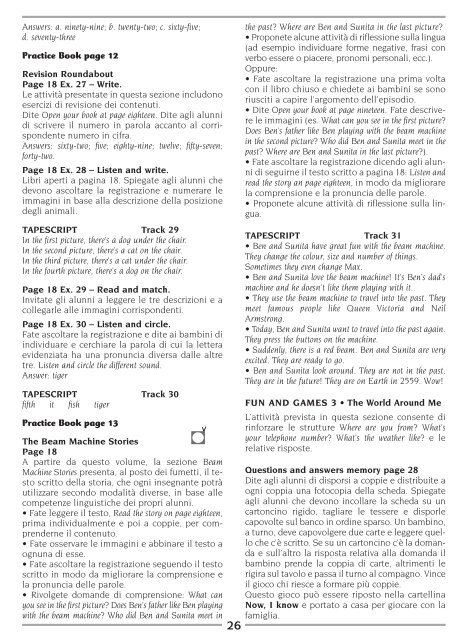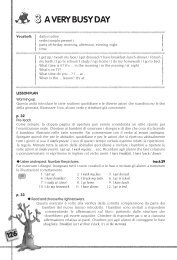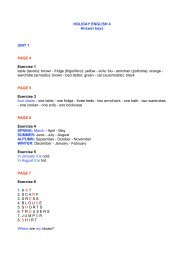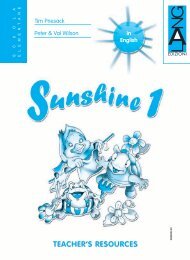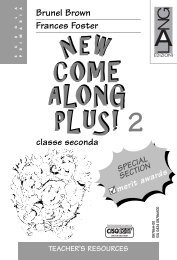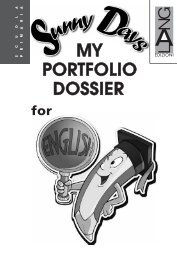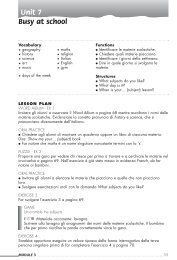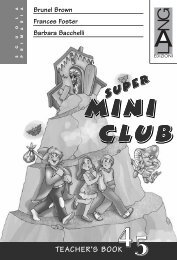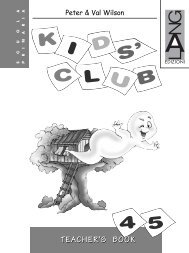You also want an ePaper? Increase the reach of your titles
YUMPU automatically turns print PDFs into web optimized ePapers that Google loves.
Answers: a. ninety-nine; b. twenty-two; c. sixty-five;d. seventy-threePractice <strong>Book</strong> page 12Revision RoundaboutPage 18 Ex. 27 – Write.Le attività presentate in questa sezione includonoesercizi di revisione dei contenuti.Dite Open your book at page eighteen. Dite agli alunnidi scrivere il numero in parola accanto al corrispondentenumero in cifra.Answers: sixty-two; five; eighty-nine; twelve; fifty-seven;forty-two.Page 18 Ex. 28 – Listen and write.Libri aperti a pagina 18. Spiegate agli alunni chedevono ascoltare la registrazione e numerare leimmagini in base alla descrizione della posizionedegli animali.the past? Where are Ben and Sunita in the last picture?• Proponete alcune attività di riflessione sulla lingua(ad esempio individuare forme negative, frasi converbo essere o piacere, pronomi personali, ecc.).Oppure:• Fate ascoltare la registrazione una prima voltacon il libro chiuso e chiedete ai bambini se sonoriusciti a capire l’argomento dell’episodio.• Dite Open your book at page nineteen. Fate descriverele immagini (es. What can you see in the first picture?Does Ben’s father like Ben playing with the beam machinein the second picture? Who did Ben and Sunita meet in thepast? Where are Ben and Sunita in the last picture?).• Fate ascoltare la registrazione dicendo agli alunnidi seguirne il testo scritto a pagina 18: Listen andread the story an page eighteen, in modo da migliorarela comprensione e la pronuncia delle parole.• Proponete alcune attività di riflessione sulla lingua.TAPESCRIPT Track 29In the first picture, there’s a dog under the chair.In the second picture, there’s a cat on the chair.In the third picture, there’s a cat under the chair.In the fourth picture, there’s a dog on the chair.Page 18 Ex. 29 – Read and match.Invitate gli alunni a leggere le tre descrizioni e acollegarle alle immagini corrispondenti.Page 18 Ex. 30 – Listen and circle.Fate ascoltare la registrazione e dite ai bambini diindividuare e cerchiare la parola di cui la letteraevidenziata ha una pronuncia diversa dalle altretre. Listen and circle the different sound.Answer: tigerTAPESCRIPT Track 30fifth it fish tigerPractice <strong>Book</strong> page 13The Beam Machine StoriesPage 18A partire da questo volume, la sezione BeamMachine Stories presenta, al posto dei fumetti, il testoscritto della storia, che ogni insegnante potràutilizzare secondo modalità diverse, in base allecompetenze linguistiche dei propri alunni.• Fate leggere il testo, Read the story on page eighteen,prima individualmente e poi a coppie, per comprenderneil contenuto.• Fate osservare le immagini e abbinare il testo aognuna di esse.• Fate ascoltare la registrazione seguendo il testoscritto in modo da migliorare la comprensione ela pronuncia delle parole.• Rivolgete domande di comprensione: What canyou see in the first picture? Does Ben’s father like Ben playingwith the beam machine? Who did Ben and Sunita meet in26TAPESCRIPT Track 31• Ben and Sunita have great fun with the beam machine.They change the colour, size and number of things.Sometimes they even change Max.• Ben and Sunita love the beam machine! It’s Ben’s dad’smachine and he doesn’t like them playing with it.• They use the beam machine to travel into the past. Theymeet famous people like Queen Victoria and NeilArmstrong.• Today, Ben and Sunita want to travel into the past again.They press the buttons on the machine.• Suddenly, there is a red beam. Ben and Sunita are veryexcited. They are ready to go.• Ben and Sunita look around. They are not in the past.They are in the future! They are on Earth in 2559. Wow!FUN AND GAMES 3 • The World Around MeL’attività prevista in questa sezione consente dirinforzare le strutture Where are you from? What’syour telephone number? What’s the weather like? e lerelative risposte.Questions and answers memory page 28Dite agli alunni di disporsi a coppie e distribuite aogni coppia una fotocopia della scheda. Spiegateagli alunni che devono incollare la scheda su uncartoncino rigido, tagliare le tessere e disporlecapovolte sul banco in ordine sparso. Un bambino,a turno, deve capovolgere due carte e leggere quelloche c’è scritto. Se su un cartoncino c’è la domandae sull’altro la risposta relativa alla domanda ilbambino prende la coppia di carte, altrimenti lerigira sul tavolo e passa il turno al compagno. Vinceil gioco chi riesce a formare più coppie.Questo gioco può essere riposto nella cartellinaNow, I know e portato a casa per giocare con lafamiglia.


